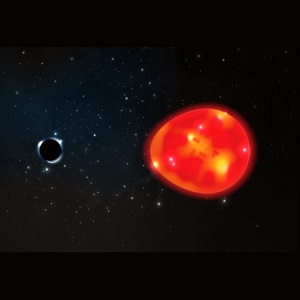Unicorn and easter eggs. Credit: Lauren Fanfer / Ohio State University.
–
Black holes, as is well known, stretch the laws of physics to the point of rupture, but when they are not feeding, they are very inconspicuous. Their real size is small and they emit practically nothing. Therefore, black holes are usually very difficult to find, even if they are relatively close to the solar system.
Readers may remember the discovery of May 2020, when in the midst of a growing pandemic, the world was captured by a black hole that was supposed to be one of the members in the HR 6819 system of two or three objects (also QV Telescopii) in the constellation Telescope. The system is about 1,000 light-years away, so it was supposed to be the nearest known black hole. The bonus was that we could see the system with the naked eye, which was also a premiere for a star-sized black hole. Unfortunately, doubts soon arose, and the prevailing view today is that it is a binary of two stars and that there is no black hole.
Fortunately, it didn’t take long and we have a new adept for the nearest black hole, even though it’s a third further than in the case of the black hole from the Telescope. The icing on the cake in this case is a luxurious nickname. The new nearest black hole is called The Unicorn, due to its uniqueness, and also comes from the constellation Unicorn.

Tharindu Jayasinghe. Credit: Ohio State University.
–
How did they find her? According to research leader Tharinda Jayasinghe of Ohio State University, their team literally conjured Unicorns out of the data. The situation in one star system is such that the simplest explanation is the presence of a black hole. If they are right, then the Unicorn is remarkable in that it is really tiny. Its mass corresponds to about 3 Suns, which is very little for a black hole. We know only the bare minimum of such black holes. It is about 1,500 light-years away.
As is usual in similar cases, his stellar partner, who can see them, was used to discover an object that is not visible. This partner is the red giant, which was closely observed by the KELT telescope at Ohio State University, ASAS (the predecessor of ASAS-SN), also at Ohio State, and also the American space telescope TESS. The data from these observations are publicly available, but so far he has never analyzed them so that he can find the Unicorn.
 –
–
Logo. Kredit: Ohio State University.
–
Jayasinghe et al. they did so and noticed that something was revolving around the red giant and that it was affecting its radiation. They also noticed that something must be both invisible and very material. The gravitational attraction of a mysterious companion brutally deforms the shape of a red giant (tidal disruption), which resembles a cosmic Easter egg. From this and other parameters, the researchers deduced that the unseen companion in question has a mass of about 3 Suns. If this is correct, then it is another very light black hole, which actually does not formally exist because it contradicts our theories. As you can see, we will have to correct the theory of black holes.
Literature
– .


